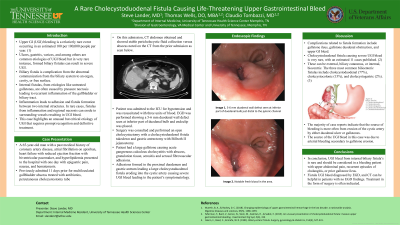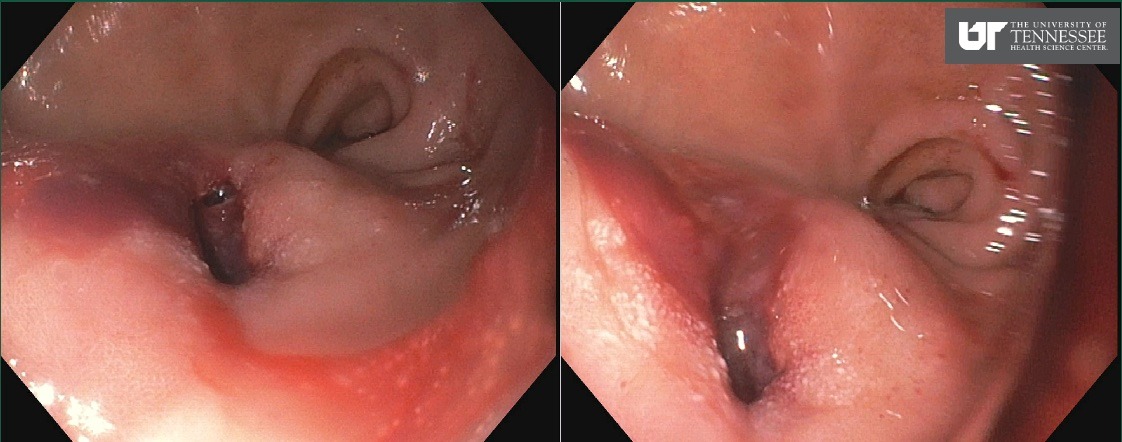Tuesday Poster Session
Category: GI Bleeding
P3493 - A Rare Cholecystoduodenal Fistula Causing Life-Threatening Upper Gastrointestinal Bleed
Tuesday, October 24, 2023
10:30 AM - 4:00 PM PT
Location: Exhibit Hall

Has Audio

Steven Lander, MD
University of Tennessee Health Science Center
Memphis, TN
Presenting Author(s)
Steven Lander, MD1, Thomas Wells, DO1, Claudio Tombazzi, MD2
1University of Tennessee Health Science Center, Memphis, TN; 2VA Medical Center and University of Tennessee, Memphis, TN
Introduction: Upper gastrointestinal (UGI) bleeds are common, occurring in approximately 100 per 100,000 people per year. An uncommon cause of UGI is a biliary fistula resulting in an UGI bleed. Biliary fistula is a complication from the abnormal communication of the biliary system to an organ, cavity, or free surface. Internal fistulas, from etiologies like untreated gallstones, are often caused by pressure necrosis leading to recurrent inflammation of the gallbladder or biliary tract. This inflammation leads to adhesion and fistula formation between two structures. As the fistula forms there can be erosion to surrounding vessels resulting in UGI bleed. This case highlights a rare but potentially life-threatening etiology of UGI bleed that requires prompt recognition and definitive treatment.
Case Description/Methods: A 65-year-old man with a past medical history of heart failure who presented to the hospital with one day history of epigastric pain, hematemesis and bright red blood in his cholecystostomy bag. The patient was previously admitted 11 days prior for gallbladder abscess treated with antibiotics and percutaneous cholecystostomy tube placement. On this admission, CT abdomen showed stable pericholecystic fluid collection versus abscess noted on the prior CT. The patient was admitted to the ICU for anemia and hypotension. EGD showed 6 mm defect along the inferior wall of the duodenal bulb. Surgery evaluated and the patient underwent cholecystectomy with cholecystoduodenal fistula takedown, antrectomy, and Billroth II jejunostomy. The patient had a gallstone causing acute gangrenous calculous cholecystitis with abscess, granulation tissue and serosal fibrovascular adhesions. Once the cholecystoduodenal fistula was identified, the surgeons were able to identify erosion into the branches of the cystic artery leading to severe UGI bleed.
Discussion: Cholecystoduodenal fistula causing severe UGI bleed is very rare, with an estimated 11 cases published. Complications related to bilioenteric fistula formation can include gallstone duodenal obstruction and upper GI bleed. Based on the published case reports, the source of bleeding is most often from erosion of the cystic artery. From what was identified during surgery, the source of the UGI bleed in this case was due to arterial bleeding secondary to gallstone erosion. UGI bleed from internal biliary fistula’s is rare and should be considered in a bleeding patient with upper abdominal pain, recurrent episodes of cholangitis, or prior gallstone ileus.

Disclosures:
Steven Lander, MD1, Thomas Wells, DO1, Claudio Tombazzi, MD2. P3493 - A Rare Cholecystoduodenal Fistula Causing Life-Threatening Upper Gastrointestinal Bleed, ACG 2023 Annual Scientific Meeting Abstracts. Vancouver, BC, Canada: American College of Gastroenterology.
1University of Tennessee Health Science Center, Memphis, TN; 2VA Medical Center and University of Tennessee, Memphis, TN
Introduction: Upper gastrointestinal (UGI) bleeds are common, occurring in approximately 100 per 100,000 people per year. An uncommon cause of UGI is a biliary fistula resulting in an UGI bleed. Biliary fistula is a complication from the abnormal communication of the biliary system to an organ, cavity, or free surface. Internal fistulas, from etiologies like untreated gallstones, are often caused by pressure necrosis leading to recurrent inflammation of the gallbladder or biliary tract. This inflammation leads to adhesion and fistula formation between two structures. As the fistula forms there can be erosion to surrounding vessels resulting in UGI bleed. This case highlights a rare but potentially life-threatening etiology of UGI bleed that requires prompt recognition and definitive treatment.
Case Description/Methods: A 65-year-old man with a past medical history of heart failure who presented to the hospital with one day history of epigastric pain, hematemesis and bright red blood in his cholecystostomy bag. The patient was previously admitted 11 days prior for gallbladder abscess treated with antibiotics and percutaneous cholecystostomy tube placement. On this admission, CT abdomen showed stable pericholecystic fluid collection versus abscess noted on the prior CT. The patient was admitted to the ICU for anemia and hypotension. EGD showed 6 mm defect along the inferior wall of the duodenal bulb. Surgery evaluated and the patient underwent cholecystectomy with cholecystoduodenal fistula takedown, antrectomy, and Billroth II jejunostomy. The patient had a gallstone causing acute gangrenous calculous cholecystitis with abscess, granulation tissue and serosal fibrovascular adhesions. Once the cholecystoduodenal fistula was identified, the surgeons were able to identify erosion into the branches of the cystic artery leading to severe UGI bleed.
Discussion: Cholecystoduodenal fistula causing severe UGI bleed is very rare, with an estimated 11 cases published. Complications related to bilioenteric fistula formation can include gallstone duodenal obstruction and upper GI bleed. Based on the published case reports, the source of bleeding is most often from erosion of the cystic artery. From what was identified during surgery, the source of the UGI bleed in this case was due to arterial bleeding secondary to gallstone erosion. UGI bleed from internal biliary fistula’s is rare and should be considered in a bleeding patient with upper abdominal pain, recurrent episodes of cholangitis, or prior gallstone ileus.

Figure: 5-6 mm duodenal wall defect seen at inferior part of duodenal bulb just distal to the pyloric channel with some fresh blood in the area
Disclosures:
Steven Lander indicated no relevant financial relationships.
Thomas Wells indicated no relevant financial relationships.
Claudio Tombazzi indicated no relevant financial relationships.
Steven Lander, MD1, Thomas Wells, DO1, Claudio Tombazzi, MD2. P3493 - A Rare Cholecystoduodenal Fistula Causing Life-Threatening Upper Gastrointestinal Bleed, ACG 2023 Annual Scientific Meeting Abstracts. Vancouver, BC, Canada: American College of Gastroenterology.
